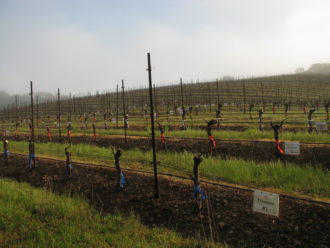The Challenge
As in all of California, water is a scarce resource in Sonoma County, a region in Northern California with more than 400 wineries and almost 60,000 acres of vineyards. Wine grape growers face increasing competition for water from different interests, various regulations, and a need to protect threatened and endangered salmonids found in the local watershed. To meet these challenges, producers must improve their water use efficiency for both frost protection and irrigation. If they can do so, they would be able to maintain grape production while at the same time minimizing impacts on stream flows critical to salmonid survival. The use of water for frost protection and seasonal irrigation specifically in vineyards has come under scrutiny by California's State Water Resources Control Board and the National Marine Fisheries. According to Karen Thomas of the Sonoma County Winegrape Commission, their regional wine grape growers needed “information on alternatives to frost protection using overhead sprinklers, on irrigation management strategies to reduce water use, and on Best Management Practices for water conservation when frost protecting and irrigating grape vines.” In order to provide this information, Thomas designed the Western SARE Professional + Producer project Water Management in Sonoma County Grape Production.
Searching for a Solution
To meet growers’ needs, Thomas’ project included a spring frost workshop along with other outreach and aimed to give guidance for the best decision-making for frost protection. The team worked with producers to fine-tune their irrigation scheduling and duration based on soil and plant water status data, vine observations, and overall strategies for wine grape production. Soil and plant moisture status were measured at vineyard sites, giving producers exposure to the technologies. The demonstration plots were located on two sites with very different soils. The team applied different irrigation regimes to different blocks and made commercial-scale wines from each block to compare to one another in tastings. The project team shared the demonstration results through workshops and field days, newsletter articles, and on the Sonoma County Winegrape Commission’s website.
What was Learned
According to Thomas, the project “demonstrated a water management technique for drip irrigation that relies on measurement, both of soil moisture and plant moisture status. The above and below ground measurements provide an excellent picture of the soil moisture dynamics of the vineyard. This gives us the confidence to push our vines further into levels of controlled stress that have benefits well beyond that of water conservation. It also allows us to produce riper fruit at lower brix while preventing excessive stress that could lead to reduced vineyard productivity and lower yields… The irrigation management demonstrations produced dramatic results. Plant and soil water status measurements resulted in delayed irrigation initiation compared to standard practices in both demonstration vineyards. Then, irrigation frequency and duration were optimized to minimize irrigation water movement beyond the active root zone. The total irrigation water supplied in the two years was 8% to 32% of crop ET at the Red Fan vineyard and 11% to 24% of crop ET at the Landslide vineyard. Those percentages are below typical deficit irrigation targets of 60% or more using crop ET models to manage irrigation.”
Impacts
Thomas maintains that Sonoma County growers have increased adoption of frost protection BMPs and use of weather station data to improve accurate decision making about frost protection.
Three frost/drought workshops were held and one Water Conservation Field Day event. These events were attended by 477 producers and partners. A survey following the Water Field Day indicated a number of producers will change practices or investigate wind machines as an alternative frost protection method. All respondents indicated they would change practices based upon the irrigation management presentation.
Post-projects Activities and Impacts
By sticking with good science and best practices, the Sonoma County Winegrape Commission is assisting producers meet the challenges provided by both Mother Nature and the politics surrounding an endangered species in a region with increasing urban-ag interface. According to Thomas, the area’s wine grape growers continue to adopt the project’s recommended practices. Because of the on-going drought in California and the need to minimize impacts to an endangered species, producers affirm the importance of changing practices in favor of greater water efficiency. To that end, the Sonoma County Winegrape Commission continues to sponsor frost protection and irrigation workshops that remind them of the recommended practices and keep them motivated toward making changes. Importantly, they have been able to demonstrate to producers that saving water saves money.
View Sonoma County Winegrape Commission Sustainability Website.
